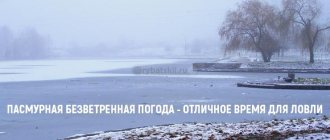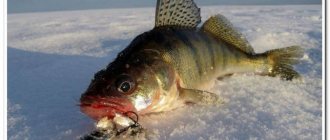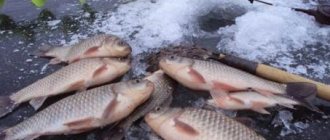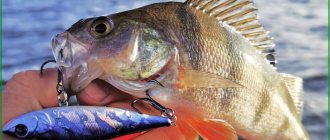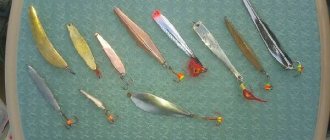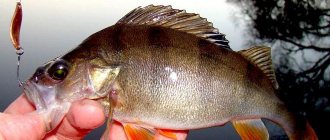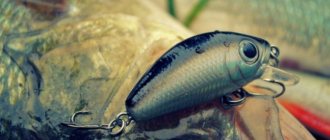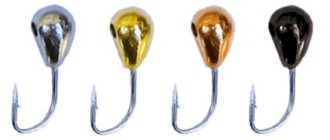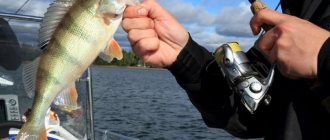Perch activity during this period
On the first ice, perch behaves very actively and can be perfectly caught throughout the daylight hours. Naturally, if the weather is favorable for this. As a rule, perch is caught well in clear, frosty weather, with even, preferably slightly increased, atmospheric pressure. The first bites begin at dawn. Unlike white fish, good lighting is important for perch.
Despite the fact that the first ice, as a rule, is characterized by a good perch bite, during the day it is caught in outings of varying duration. In November-December, the best bite lasts from morning until lunch. Then follows some break, and after lunch the bites continue.
As dusk approaches, the activity of the perch subsides. A good perch bite begins from the moment ice cover is established and, depending on the course of the winter and the region, lasts from two weeks to a month, or even a month and a half. Further, activity peaks coincide mainly with favorable weather conditions.
Up
Selecting gear
Lures on the first ice are no different from winter ones; they are still the same jigs, spoons and balancers. For jigs and small spinners there is no need for a long fishing rod. It will be sufficient to use a 20-25 cm balalaika with a sensitive nod. For balancers, fishing rods up to 40 cm with a stiffer nod are used.
Reel or reel doesn't matter. The diameter of the fishing line is selected depending on the fishing conditions. If the river or lake is small, with depths up to 8 meters, then 0.12 mm will do. On large lakes and rivers with large working depths, the diameter should be thicker, up to 0.22 mm. Winter fishing line is sold in coils of 15-30 meters. The reel is reeled with a margin of 5-10 meters from the expected fishing depth.
Finding a fishing spot
On first ice, the main task is to find perch. Having stumbled upon an active school, you can “do” the whole fishing in an hour or two. The first ice is thin and often transparent, so you can’t make noise on the ice, throw an ice pick or drill, move a box loudly, or shout. The fish reacts very sensitively to noise and leaves or stops biting. Perch, although quite tolerant of noise, also does not like unnecessary noise. Basically, the favorite stopping places of perch differ in their characteristic features.
Large bodies of water and reservoirs
On large bodies of water – lakes and reservoirs – searching for perch can be quite a lengthy task. Success can often be achieved with a good knowledge of the bottom topography. Perch, especially large ones, gravitate toward bottom anomalies. These can be ditches, local hills with sharp slopes, beds of flooded rivers with snags.
It must be said that when there is first ice, perch often does not yet go to the depths and from shallow waters, with reed islands, and algae fields. In such places, he continues to actively hunt for fry and collect other aquatic life. Subsequently, dying vegetation worsens the oxygen regime and all fish, including perch, go to sources of water saturated with oxygen.
Small rivers
On small rivers, by the first ice, perch often already moves away from the coastal vegetation and concentrates in deeper places or close to them - in whirlpools, at outlets - entrances to pits, in deep rubble and snags.
Only the “sailors” remain in the coastal zone. In small rivers it is important to find at least small shelters at the bottom; it rarely stands in clean places. In rivers, perch almost never stands on the stream; in exceptional cases, during the current it can hide behind stones, logs, or hummocks.
The situation may change if, before the freeze-up, the water in the river arrived and heavily flooded the coastal thickets. Then, moving away from the strengthening current, schools of perch can cruise along the shore. But fishing here can be very fleeting: only bites followed one after another, and after 15 minutes it was all over - the flock left. To summarize, we can say that in rivers you need to look for sufficient depths with shelters.
Ponds
Pond perch are widely dispersed throughout the water area and rarely create a high density. On ponds, search is the key to success. Sometimes you have to drill holes literally every 2-3 meters. On the first ice you need to look for islands of vegetation, windows in the thickets; good fishing is obtained near dams and dikes. Quite quickly after freezing, the perch slides into the deepest parts of the pond.
Finding big bass
Large perch, whether in open water or after ice has established, do not form large schools. Depending on the reservoir, such a flock can contain from 2-3 to 10-20 individuals. Large perch always gravitate to the depths, “strong” places. On large rivers and reservoirs it often coexists with pike perch and large schools of whitefish.
Good, trophy humpback whales from half a kilogram and above rarely coexist with their smaller counterparts. And, if you are looking for large fish, after a few bites of small perch, you can move on - there are no large perch here.
Up
Tackle.
When the air temperature balances around zero and even more steadily drops into the negative range, leave a graphite spinning rod in a warm apartment. Carbon fiber is different from carbon fiber, but I would not advise you to subject an expensive “stick” to a survival experiment. After all, there have been so many cases when, in the cold, carbon fiber-based fishing rods simply crumbled under moderate loads. A fiberglass spinning rod with a maximum cast weight of 15-30 grams is best suited for our cases. Its power is slightly higher than that typical for medium-sized perch rods, but there are two explanations for this: late autumn perch baits are several times heavier than summer spinners and twisters, and the perch on the eve of winter is larger. Due to the greater weight of the bait, any reel can be used. The diameter of the fishing line on a spinning reel is 0.24-0.27, on an inertial one - 0.30-0.36 millimeters.
Methods and gear
Winter fishing rod
The winter fishing rod is used when fishing with jigs, spinners and balancers. In principle, any winter fishing rod that is convenient for the fisherman himself is suitable for catching perch with a jig. The only nuance of fishing on the first ice is a comfortable, large reel, which allows you to quickly reel in the tackle during an active search.
For fishing with large artificial baits, if you intend to catch perch, somewhat lightweight fishing rods with a rigid nod are used. The nod registers even vague bites and helps you experiment with the game. For jig fishing, a fishing line with a thickness of 0.1-0.15 mm is used, for large perch up to 0.18. Fishing rods for spinners and balancers are equipped with a fishing line of 0.18-0.25 mm.
Zherlitsy
In a number of reservoirs, fishing for large perch using girders is successfully practiced. This type of fishing line differs from the classic winter one in the absence of rigid leashes, a fishing line thickness of 0.2-0.3 mm, and a small single or double hook. The live bait used is small, runaway fish - gudgeon, bleak, roach, dace or minnow. Despite the large mouth, the perch often knocks down and throws large baitfish, which leads to a huge number of empty strikes.
Up
Seductive fishing for autumn perch
In the fall, large perch can be tempted by bottom fishing, preferably in steps, that is, the bait either sinks to the bottom, then, obeying two or three turns of the reel, moves and falls to the bottom again. The bite occurs more often when the bait is lifted from the bottom and during a pause. Often, perch can be irritated by twitching, that is, reeling in with twitching of the bait using a spinning rod, here it is better in the bottom position. It is also possible to move the bait slowly, almost dragging it along the bottom.
Lures and baits
Classic jig
classic jig and its types
Perch is quite picky about baits and the jig itself. Traditionally, red, black, silver, and brass jigs are used. An ordinary bloodworm works well as a nozzle. The perch is indifferent to maggots; sometimes the larva of the burdock moth “shoots out”.
When the bite is active, lard, fish eye, and even perch fin work in some reservoirs. You can use earthworm pieces. Classic perch wiring is considered to be “trembling” with a high frequency. An inactive perch is often tempted to abruptly change the retrieve - from fast to slow or vice versa.
Mothless
types of reelless gear
Rewindless gear involves constant active play with a jig. There are no uniform “perch” recipes for the shapes and colors of jigs. Here the preferences of the fish depend both on the reservoir and on the angler’s technique. Most often, the shape and color scheme of jigs, devils, and witches are selected with the obligatory presence of contrasting elements.
For example, a black jig has a yellow bead or cube on the fore-end, a silver jig with red beads, a poisonous green banana with transverse black stripes, etc. The main colors are black, orange, red, purple, gold and silver. Suspensions made of chains, beads or cubes work well for perch. You can attach foam or silicone balls to the hooks of devils or witches.
Spoons
The choice of spinners for winter perch fishing is huge. Any winter spinner has in his arsenal the most catchy specimens, which he would not exchange for anything. For catching perch, mainly narrow, elongated spoons 20-50 mm long are used. The hook can be rigidly soldered into the body of the spoon, connected to it through a ring, or located on a chain.
The most common are white and yellow spinners. Vertical and gliding lures are used, which are distinguished by their play on the fall. Sometimes a hook with a cambric or thread is tied above the spoon on a short leash.
Balancers
balancers
The balancer has recently successfully competed with spinners and has become one of the most popular baits for catching perch, especially large ones, from the ice. It is noted that the most attractive colors for catching perch are a combination of “acid” green, orange, red tones with stripes and dots.
The drop-shaped sagging on the lower tee shows itself well. Moreover, there are periods when the perch only grabs this suspension. It is believed that perch balancers are quite small and light. However, sometimes it happens that the perch only reacts to large bait. Taking this into account, in the box, in addition to traditional perch balancers, you need to have several large and heavy baits.
Rathlins and cicadas
ratlins
cicada
“Summer” baits perform well in large bodies of water. Ratlin successfully catches both perch and pike perch, so when fishing for them it is advisable to use a fluorocarbon leader.
The situation with the cicada is especially interesting; there are reservoirs where the cicada leaves all other baits far behind and the perch literally hangs itself on it. On others, he ignores her altogether.
It is advisable to have both of these baits in the most popular sizes and colors in your arsenal. It must be taken into account that the average size of ratlins and cicadas for catching perch is smaller than for other predators.
Silicone
vibrating tails for winter fishing
For ice fishing, 1.5-2.5 inch vibrating tails on jig heads are mainly used. Such an installation often helps out when fishing in strong debris, when baits with active action, such as spinners or balancers, are guaranteed to remain in the wood. The low cost of consumables and the ease of fishing with silicone baits are quite attractive in such conditions.
Up
Lures and lures for catching perch on the first ice
Winter perch fishing involves the use of jigs, spinners or balancers. If you choose the right size and color of the bait, then in any case the fishing will be successful. Despite this, larger specimens prefer a spinner or a balancer. When the first ice appears, the activity of the fish is quite high, which means that it can provide serious resistance when fishing. In this regard, you should not use fishing line whose thickness may be less than 0.15 mm. This is just the diameter that will allow you to safely catch good individuals. When pulling a fish out of a hole, you should not hold the line on the edge of the hole, much less allow the edge of the hole to serve as a support for it. The line may simply fray and then you can forget about the fish.
As for spinners and balancers, when fishing on the first ice, their optimal size is 30-40 mm. Both the spoon and the balancer have their own unique game, which can be decisive in terms of successful fishing. Perch may prefer lures of red, yellow or silver colors. Since perch feeds on bleak and does not mind swallowing its fellow fish, baits that imitate perch or bleak work great. Paradoxically, perch relatives make up the lion's share of its diet.
In addition to spinners, perch is excellently caught using jigs. When he shows his maximum activity, he doesn’t go overboard with baits. Therefore, the shape and color of the jig do not play a special role. To be more confident in the effectiveness of fishing on the first ice, you should attach a worm, bloodworm, maggot or other bait attractive to perch to the jig. If you don’t do this, the bites may stop or become sluggish and unsure.
Despite this, there are cases when the perch pecked at everything that was offered to it, without adding various baits. In such cases, you can use any baitless bait.
Winter fishing is one of the most wonderful forms of recreation. It allows you not only to enjoy the process of fishing, although in most cases it is not a large perch that is caught, but also to breathe in plenty of crystal clear air. This is despite conditions that cause many inconveniences. Firstly, clothing that is designed to keep warm, and secondly, severe frosts that do not allow fishing without mittens. But these inconveniences are not a hindrance for real fishermen.
Adviсe
Feeding
As a rule, on the first ice, the key to successful perch fishing is active search and there is no point in feeding one spot. But in some conditions, for example in reservoirs, ponds and some rivers, when the fish are very dispersed and even moving, bait can play a positive role.
To feed perch, mainly small bloodworms are used. If the fish is generally active, the bites are clear but rare, you need to pour out the starting feeder of bloodworms. It is advisable to open the feeder at a certain height from the bottom in order to increase the area of the feeding spot without creating a large concentration of feed at one point. A wide spot is more noticeable, but does not allow the fish to get enough quickly.
If after the first feeding the number of bites has increased, then during the fishing process you can make additional half-portion feeding when the bite dies down.
Rocking the hole
It happens that we know for sure that there is a perch below, but for some reason it doesn’t take it. In this case, the so-called “swinging of the hole” can help. This method works well both when fishing with jigs and when fishing with spoons and balancers.
When fishing with a jig, you immediately perform a fast, high-frequency, low-amplitude retrieve from the bottom to the maximum height, then one or two more. The next wiring is done more slowly and at a lower frequency.
If there is no result, everything is repeated again. When fishing with spoons and balancers, several active throws are performed without pauses. Then, after throwing, you need to wait until the vibrations of the bait die out and pause for a few more seconds. Often, this is followed by a bite.
This option of fishing a hole also works. After catching several perches on a balance beam or spoon, the bite stops. Then you can take out a jig and catch a few more fish from the same hole.
Up
Winter lure of perch
The perch bite at the beginning of winter is stable. Flocks of striped fish stay close to the places where the fry are present, follow them and look for food throughout the water area.
- At this time, there is no need to reinvent the wheel with delicate gear, nuances of feeding and searching, as in the wilderness.
- The task when trolling a perch on the first ice is to find a predator. The conditions are conducive - the ice is thin and drilling is easy. In one fishing trip it’s not difficult to drill several dozen holes and check them.
- Ice fishing for perch, regardless of the gear used, is conventionally divided into hunting for an active predator or a passive one. First ice is the time for active perch, and the fisherman’s actions are based on this.
- The tendency is that instead of hammering the same hole with different baits, if it doesn’t bite, it’s better to move and find a working point.
More information about winter perch fishing:
Rules of conduct on ice
We must remember that the first ice is very treacherous. It is believed that the safe thickness of transparent ice is more than 7 centimeters, and frosted ice is more than 10. Often, especially on rivers and reservoirs with a current, in backwaters, creeks, and reaches, the ice is already quite strong, and closer to the main stream only a thin crust is frozen.
You need to beware of snow drifts on the ice, dark spots, frozen islands of vegetation; here the ice is the least durable. Therefore, maximum caution is necessary; it is advisable not to go out on the first ice alone.
When traveling with a group, you must have a piece of strong rope with knots tied on it so that you can pull out a colleague who gets caught in the wormwood. For getting out of the water onto the ice, the so-called “rescue rescuers” are very helpful - pointed metal pins with a handle that can be stuck into the ice and, leaning on them, get out of the ice font.
The first solid ice appears on small ponds and lakes, then on reservoirs and rivers. Some rivers can be dangerous all winter, and not just during the first ice. On thin ice you cannot gather in “bazaars”, especially when it is clear that water is flowing out of the holes.
Features of fishing on first ice
With the arrival of winter, most summer fishermen leave the reservoirs with sadness in their hearts and go on so-called vacations, which will end only in the spring. But the bravest and bravest adventurers cannot give up what they love, knowing that at the beginning of the winter season there are good chances to get a real trophy from the depths of the water.
Winter fishing is a great way to have a great free time, recharged with new emotions and excitement. With the right approach and taking into account the key subtleties of fish behavior in winter, you can arrange an unforgettable pastime with trophy results.
But if you are new to this field and have never fished from ice before, do not forget about your own safety measures. At the beginning of December, the ice can be very thin , so you need to go out on it with extreme caution. Particular attention is paid to places where underwater springs flow or any other sources of increased temperature are present - the ice there is much thinner than in the rest of the zone.
To avoid trouble, you should adhere to the following precautions:
- Do not go fishing alone, and also do not forget about buying or making special life preservers.
- When going out on the ice, you need to check its strength with an ice pick. If after one blow the surface does not crack, then you can take further steps.
- If fishing takes place in conditions with intense currents, then it is important to remember that the ice there does not freeze equally. At depth and in places with actively springing springs, it is much thinner. Therefore, each new step must be accompanied by preliminary tapping of the ice with an ice pick.
- Ice density among thickets of vegetation is minimal. It's not safe to walk there.
- Standing water freezes much faster than running water. Therefore, it is better to start fishing on first ice on lakes or reservoirs.
Mormyshka
Experienced fishermen claim that the color of the jig affects the catchability. Perch often pays more attention to the red color.
The size of the jig when fishing on first ice is recommended to be 3-3.5mm. A jig that is too small may be left unattended when the perch is preparing for winter.
Replanting
It is best to fish with a jig using bait:
- earthworm pieces;
- mormysh;
- maggot;
- burdock moth larva;
- large bloodworm.
It is better to use the jig with smooth strokes and small vibrations, gradually raising the jig from the bottom to the surface.


